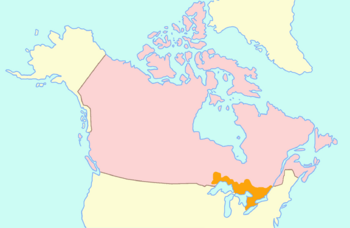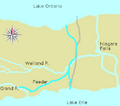Upper Canada facts for kids
Quick facts for kids
Province of Upper Canada
|
|||||||||
|---|---|---|---|---|---|---|---|---|---|
| 1791–1841 | |||||||||
|
Flag
|
|||||||||

Map of Upper Canada (in orange) with 21st-century Canada (in pink) surrounding it
|
|||||||||
| Status | British colony | ||||||||
| Capital | Newark 1792–1797 (renamed Niagara 1798, Niagara-on-the-Lake 1970) York (later renamed Toronto in 1834) 1797–1841 |
||||||||
| Common languages | English | ||||||||
| Government | Family Compact oligarchy under a Constitutional monarchy |
||||||||
| Sovereign | |||||||||
|
• 1791–1820
|
George III | ||||||||
|
• 1820–1830
|
George IV | ||||||||
|
• 1830–1837
|
William IV | ||||||||
| Lieutenant-Governor; Executive Council of Upper Canada | |||||||||
| Legislature | Parliament of Upper Canada | ||||||||
| Legislative Council | |||||||||
| Legislative Assembly | |||||||||
| Historical era | British Era | ||||||||
| 26 December 1791 | |||||||||
|
• Act of Union 1840
|
10 February 1841 | ||||||||
| Area | |||||||||
| 1836 | 258,999 km2 (100,000 sq mi) | ||||||||
| Population | |||||||||
|
• 1823
|
150196 | ||||||||
|
• 1836
|
358187 | ||||||||
| Currency | Halifax pound | ||||||||
|
|||||||||
| Today part of | |||||||||
Upper Canada was a British colony in North America. It existed from 1791 to 1841. Today, this area is the southern part of the province of Ontario in Canada.
The colony was created for people loyal to Britain. Many of these people had moved from the United States after the American Revolution. They wanted to live under British laws and customs.
Contents
Upper Canada: A British Colony
Upper Canada was a very important part of British North America. It was known for its English-speaking population. This was different from Lower Canada (now Quebec), where most people spoke French.
What Was Upper Canada?
Upper Canada was a land of forests, rivers, and lakes. It stretched from what is now the eastern border of Ontario to Lake Huron. The colony was mostly rural, with small towns and farms.
The British government wanted to develop this area. They encouraged people to move there. Many settlers came from Britain and the United States.
How It Started
Upper Canada was formed by the Constitutional Act of 1791. This law divided the old Province of Quebec into two parts. The western part became Upper Canada. The eastern part became Lower Canada.
The Act gave Upper Canada its own government. It had a governor, a legislative council, and an assembly. This was a big step for the colony.
Life in Upper Canada
Life in Upper Canada was often hard. Settlers had to clear land and build homes. They farmed crops like wheat and corn. Many people also worked in the fur trade or timber industry.
The main language spoken was English. The currency used was the Halifax pound. People relied on rivers and lakes for travel and trade.
Growing Towns and Cities
The first capital of Upper Canada was Newark. It was a small town near Niagara Falls. Later, the capital moved to York in 1797.
York grew into a busy town. It was renamed Toronto in 1834. Other towns also started to grow, like Kingston and London. By 1836, the population of Upper Canada was over 350,000 people.
Who Was in Charge?
Upper Canada was ruled by the British King or Queen. They appointed a Lieutenant-Governor to manage the colony. The Lieutenant-Governor had a lot of power.
The colony also had a Parliament. This included a Legislative Council and a Legislative Assembly. The Legislative Council was chosen by the British. The Legislative Assembly was elected by the people.
A group called the Family Compact had a lot of influence. They were a small group of wealthy and powerful families. They held many important positions in the government and society. This group often made decisions that benefited themselves.
The End of Upper Canada
Over time, many people in Upper Canada wanted more say in their government. They felt the Family Compact had too much control. This led to some disagreements and even small rebellions.
To solve these problems, the British government passed the Act of Union 1840. This law joined Upper Canada and Lower Canada together. They became the United Province of Canada in 1841. This marked the end of Upper Canada as a separate colony.
Images for kids
-
The Sharon Temple, built by the Children of Peace
-
The Rideau Canal in Ottawa, Ontario, Canada, with Parliament Hill and the old "Union Station" visible in the background
-
Huron Tract Purchase area, located in Southern Ontario, highlighted in yellow
See also
 In Spanish: Alto Canadá para niños
In Spanish: Alto Canadá para niños
























